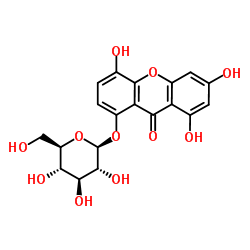norswertianolin
Modify Date: 2024-01-08 12:39:03

norswertianolin structure
|
Common Name | norswertianolin | ||
|---|---|---|---|---|
| CAS Number | 54954-12-0 | Molecular Weight | 422.340 | |
| Density | 1.8±0.1 g/cm3 | Boiling Point | 833.7±65.0 °C at 760 mmHg | |
| Molecular Formula | C19H18O11 | Melting Point | N/A | |
| MSDS | N/A | Flash Point | 300.4±27.8 °C | |
Use of norswertianolinNorswertianolin acts as a CSE activator and is isolated from G. acuta. Norswertianolin may be a potential agent for cardiovascular diseases[1][2]. |
| Name | norswertianolin |
|---|---|
| Synonym | More Synonyms |
| Description | Norswertianolin acts as a CSE activator and is isolated from G. acuta. Norswertianolin may be a potential agent for cardiovascular diseases[1][2]. |
|---|---|
| Related Catalog | |
| Target |
CSE[2] |
| In Vitro | Norswertianolin (3.125~50 μM; H9c2 cells) has the protective effects on H2O2-induced H9c2 cells. Norswertianolin significantly increases the transcription levels of HO-1 and GCLC in H9c2 cells[1]. Norswertianolin (0~150 μM; HepG2 cells) high concentration increases the CSE protein level[2]. |
| In Vivo | Norswertianolin (4.4 mg/kg/day; s.c.; 1 week) improves CSE/H2S production[2]. Norswertianolin treatment attenuates the renal tubular injury in acute I/R. Norswertianolin also reduces I/R-stimulated ROS by DHE fluorescence intensity. Norswertianolin has anti-hypertension effects, inhibits vascular remodeling and reduces inflammation effects[2]. Animal Model: Male Sprague Dawley rats (10~12 weeks)[2] Dosage: 4.4 mg/kg/day Administration: S.c. Result: Improved CSE/H2S production. |
| References |
| Density | 1.8±0.1 g/cm3 |
|---|---|
| Boiling Point | 833.7±65.0 °C at 760 mmHg |
| Molecular Formula | C19H18O11 |
| Molecular Weight | 422.340 |
| Flash Point | 300.4±27.8 °C |
| Exact Mass | 422.084900 |
| PSA | 190.28000 |
| LogP | -1.66 |
| Vapour Pressure | 0.0±3.2 mmHg at 25°C |
| Index of Refraction | 1.758 |
| 4,6,8-Trihydroxy-9-oxo-9H-xanthen-1-yl β-D-glucopyranoside |
| 9H-Xanthen-9-one, 8-(β-D-glucopyranosyloxy)-1,3,5-trihydroxy- |